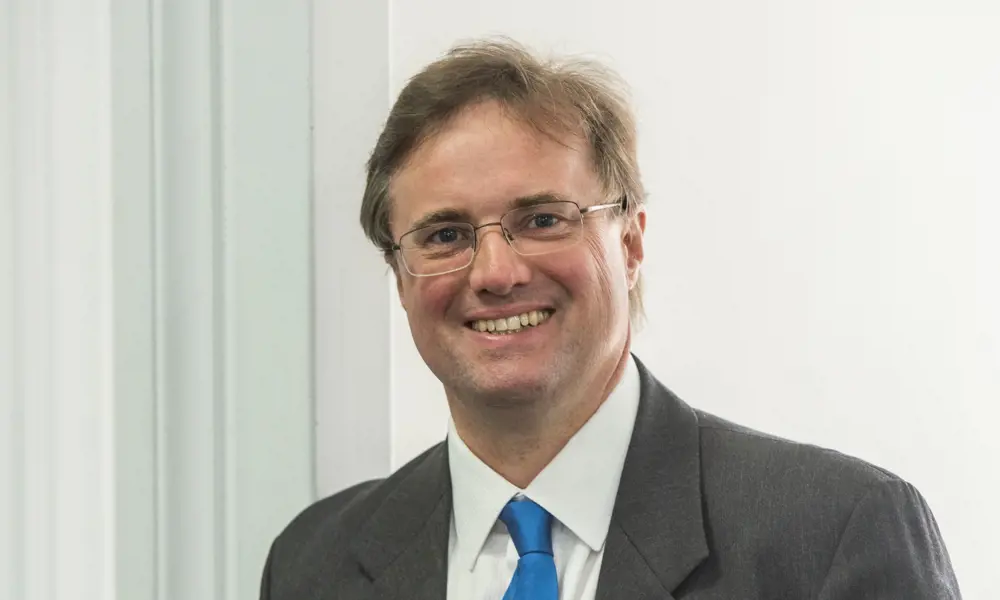
A talent for bursting bubbles
A typical research career seemed likely for Professor Timothy Leighton FREng FRS when he was studying undergraduate physics at the University of Cambridge. He was interested in astrophysics and cosmology, but felt the urge to get into the laboratory. “There was a part of me that wanted to feel something real between my hands,” he explains. Instead of diving into an undergraduate project that needed impressive equipment, molecular beam epitaxy for example, he chose an area that was, as he puts it, “an acorn that could turn into an oak tree”. His attention turned to underwater acoustics, such as what creates the sound of a babbling brook. It kick-started a career investigating the physics of sound in liquids.
His attention turned to underwater acoustics, such as what creates the sound of a babbling brook. It kick-started a career investigating the physics of sound in liquids
Professor Leighton wanted to continue in the same area when it came to a PhD project. Underwater acoustics might not have been mainstream research at the Cavendish Laboratory (Cambridge’s physics department) at the time, but it had the limited amount of equipment he needed to carry out high-speed photography, for example. He received backing from a visiting academic that helped to convince a professor so that he could continue studying the physics of bubbles in liquids. “It amused him as a strange offshoot,” adds Professor Leighton.
The undergraduate project had focused on how gas bubbles trapped by breaking waves or a waterfall make a sound. For his PhD, Leighton reversed the process; rather than listening to what came out of a fluid, he set out to research what happened when he injected sound into it. In particular, he set out to research what happens when sound enters the womb to scan foetuses, an issue that raised safety issues as the foetus is a delicate tissue. “Any mechanical system that makes a sound will vibrate if you shoot sound at it close to its natural frequency,” he says. “The megahertz frequencies needed to get nice spatial resolution in images would resonate with microscopic bubbles, which feasibly you might have in the body. Nobody knew at the time.” Thus, began a research career that applies physics in real-world applications.
For his PhD, Leighton reversed the process; rather than listening to what came out of a fluid, he set out to research what happened when he injected sound into it
Professor Leighton completed his PhD and some follow-up work, which gave him early exposure to something that became increasingly important in his research. “It helped me to get an all-round picture of the different environments that people work in.” His research generated close links with the local hospital, and he came to understand the relationship between clinicians and medical physicists. Professor Leighton realised that the equations at the heart of his work would have little impact on anyone without an understanding of those relationships, the limitations and the environment people were in.
His first papers appeared amid debates about the safety of ultrasound in foetal monitoring. “The ultrasound images back in the seventies were black and white and grainy. It was hard to see anything. If you look at today’s images, they are brilliant.” The work elicited an invitation from the World Federation for Ultrasound in Medicine and Biology to join a working party on the guidelines for safe foetus scanning. “I popped off to Japan, where people from many countries, industry and academia, and the healthcare sector got together and thrashed through the various hazards. I was by far the youngest there, so incredibly lucky and grateful to be given an unparalleled opportunity to work with the pioneers whose papers I had been reading,” he adds. The working party came about because there was growing interest in the safety of ultrasound scanning, especially in the USA. Medics wanted ever more detailed images but that meant pushing up the sound frequency. Scanner makers could deliver that, but higher frequencies are more strongly absorbed and that means greater heating, which could increase the risk of damage to the foetus. The working group set out to provide answers on safety. As Professor Leighton describes the process: “It was basically about coming to a resolution, while being wise enough to take into account the big picture, which I thought was engineering.
It was based on rigorous maths, careful experimentation, considering the social, economic and ethical dimensions, and coming up with a set of guidelines that I am very proud of
“It was based on rigorous maths, careful experimentation, considering the social, economic and ethical dimensions, and coming up with a set of guidelines that I am very proud of.” The effect was widespread. “Since then, two billion children have been scanned under these guidelines.
“Over the years, the power output of these machines was going up and up and up at a huge rate. I think the scientific community did a good job of putting a line in the sand and saying ‘These are the hazards. This is how you would calculate them’.”
One outcome of the guidelines was the development of onscreen displays on all scanners that showed the likelihood of various hazards to the foetus for the settings in use, which allowed operators to judge possible risks. “There are a couple of numbers shown on the screen. They don’t say ‘You can’t exceed this’. They advise the clinician of the likelihood of a problem, so the clinician would know that, if what they are doing is lifesaving, disregard those numbers – they are a lower priority than the medical procedure. But if the procedure is routine, you should not exceed those numbers.”
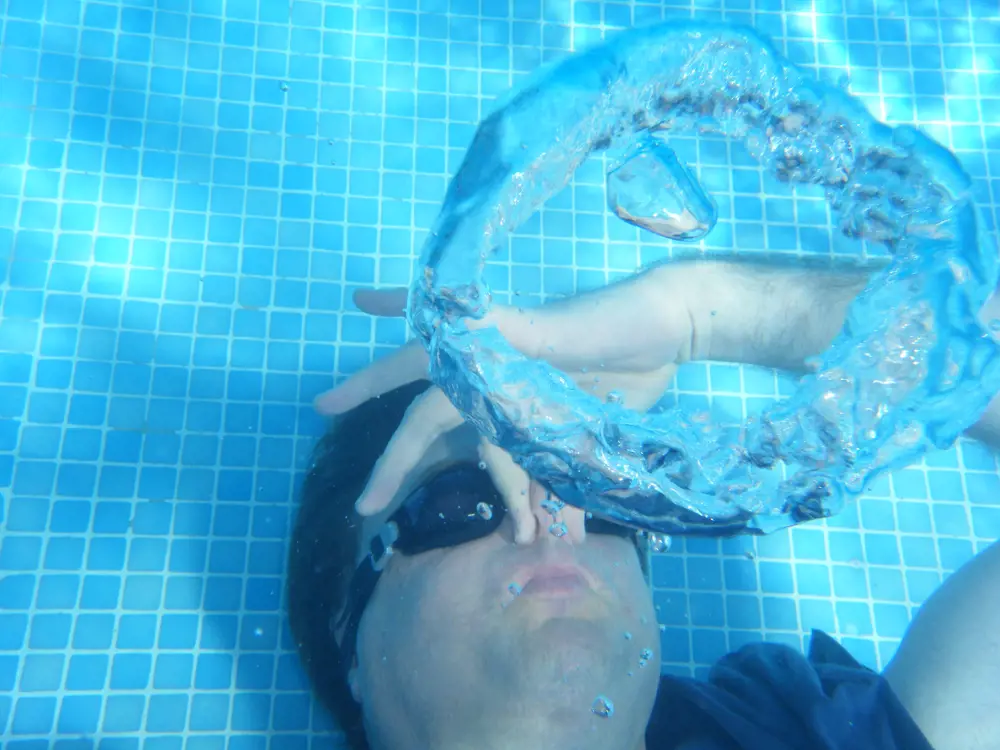
Professor Leighton was inspired to invent TWIPS (twin inverted pulse sonar), and from there TWIPR (twin inverted pulse radar), with colleague Paul White after watching dolphins hunting with bubble nets. He also saw dolphins blowing and playing with bubble rings (whether this is for recreation or education is not known) and decided to solve the problem of how they did this while he was in a swimming pool when on holiday in Menorca
Problem solver
Professor Leighton’s work on foetal scanning set the pattern for his career; he wanted to have positive effects on people’s lives. In 1992, this thinking guided his research when he moved to what is now the Faculty of Engineering and the Environment at the University of Southampton to join the Institute of Sound and Vibration Research. Writing papers was not enough; although his tally is now well over 400 publications, studying the physics of sound underwater fuelled his engineer’s desire to create technologies that would solve problems. For example, collaboration with a team from the National Oceanography Centre in Southampton produced GeoChirp 3D, the first truly three-dimensional sub-seabed profiler (a way of looking at what is under the seabed). The technology was used to image the skeleton of The Invincible, a Royal Navy ship that sank in the Solent in 1758. That research has yielded equipment for conducting sonar surveys of the seabed, in marine archaeology and geology, such as researching landslides in Norwegian fjords. In a different domain, Professor Leighton’s team has developed sensors for the US Department of Energy’s neutron-scattering facility.
studying the physics of sound underwater fuelled his engineer’s desire to create technologies that would solve problems
Back in the medical world, Professor Leighton’s problem-solving helped to develop needle-free injectors to treat migraines, as well as LithoCheck, an ultrasound ‘smart stethoscope’, developed with Guy’s and St Thomas’ NHS Foundation Trust, to predict what is going on when doctors use ultrasound, or shock-wave lithotripsy, to treat kidney stones. The idea is to tell doctors when treatment has succeeded and to prevent over exposure to ultrasound and the risk of damaging healthy tissues. The natural world was also an obvious subject. Professor Leighton’s research has taken in whale sounds, dolphins, fish and bubbles in surf. “We were the first people to measure the bubble population in the surf – how the oceans breathe,” he says. He was also the first to propose how humpback whales get together to produce ‘walls of sound’, bubble nets, to catch prey. Rather than being purely a zoologist’s problem, Professor Leighton says that this is an engineering issue; as is the maths that dolphins use in their heads when they are processing signals. He concluded what that maths was, and so devised the world’s only sonars (twin inverted pulse sonar and biased pulse summation sonar) that can detect mines in bubbly seawater.
Rather than being purely a zoologist’s problem, Professor Leighton says that this is an engineering issue; as is the maths that dolphins use in their heads when they are processing signals
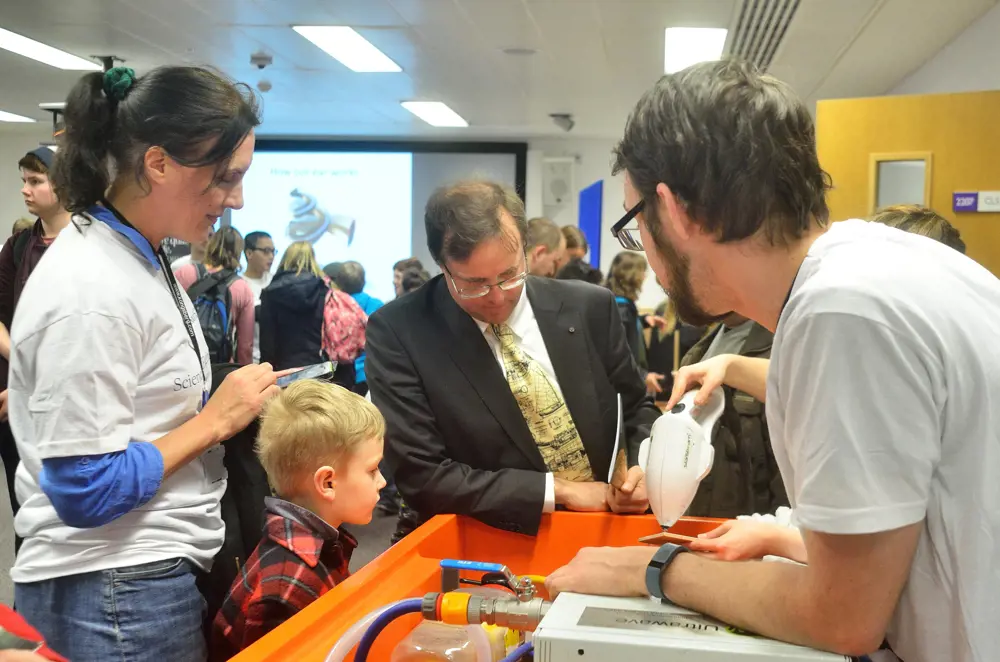
Public engagement has been an important part of Professor Leighton's latest venture into overcoming antimicrobial resistance
Public Engagement
Research into these areas aroused media attention and fuelled Professor Leighton’s enthusiasm for public engagement. “I am very committed to public engagement. I get a big kick out of it, whether it is with fiveyear-olds or people who are double my age.” His public engagement activity has included time as a member of the Royal Academy of Engineering’s Ingenious panel. He believes that the scheme, which awards grants up to £30,000 for public engagement activities to promote engineering, appears to be working well and has raised the bar enormously. “Ten years ago you could propose something that would easily have got funded, that would not stand a chance today. If you thought ‘I am going to impress the kids with 3D printers, I’m going to produce a movie and put it on YouTube’, forget it. That is not enough.” The goalposts have moved. “Ten years ago we were asking academics and engineers just to get interested in talking to the public. However, today public engagement cannot be a one-way process, with engineers passing on their ‘wisdom’,” he says. “It is about creating meaningful dialogues and not simply talking at people. You should be finding out what is in their hearts and minds. You should be a person with a watering can, nurturing any seeds you find, helping them to grow, giving your full attention to the person in front of you.”
It is about creating meaningful dialogues and not simply talking at people
Public engagement has been important in Professor Leighton’s latest venture, which has taken him in an unexpected direction. He has set himself no less a task than trying to overcome the problem of antimicrobial resistance (AMR). The medical world talks in terms of an ‘antibiotic apocalypse’, the notion that sometime soon, perhaps around 2050, so many bacteria will have evolved that can resist all known antibiotics that AMR could be killing more people than cancer.
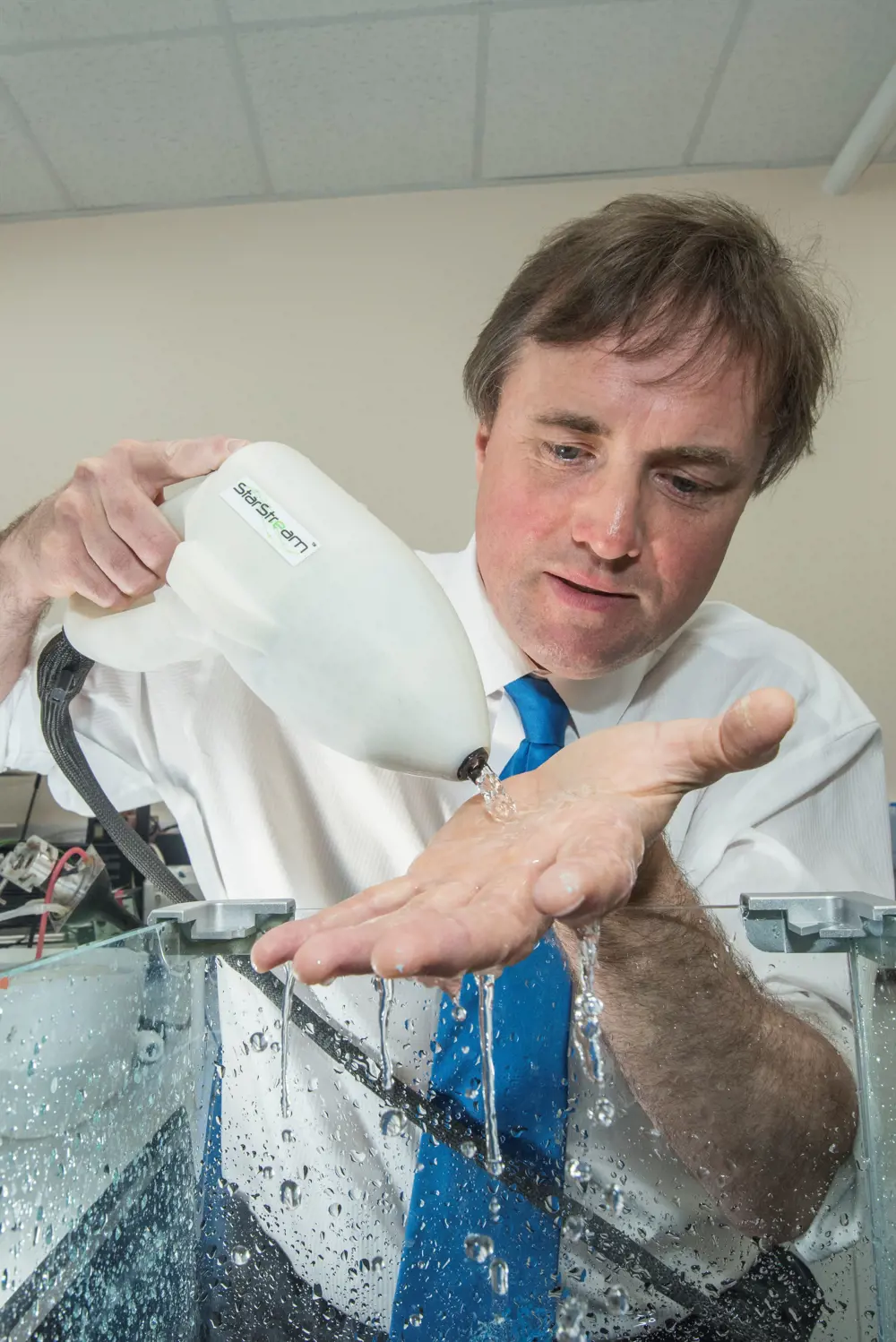
The StarStream device looks like a small hairdryer, but dispenses a stream of room-temperature water instead of hot air
Against resistance
Chemists and the pharmaceuticals industry see new antibiotics as the solution to AMR, but Professor Leighton has other ideas. “I could see that there was a disconnect between the size of the problem and the way that we were thinking about it,” he explains. Bacteria will develop resistance to new antibiotics. Why not take advantage of a technology that does not change the gene pool of the bugs? “The mindset of the community has to change before they start seeing that there are other potential solutions.”
Professor Leighton’s move into AMR started when he tried to persuade the community to change that mindset. He wanted the medical world to consider using ultrasound to clean wounds, avoiding the antibiotic treatments that, through natural selection, contribute to the development of antibiotic resistance in bacteria. He even had an invention that could take on the task, a device that came out of what he calls his ‘toy factory’. In reality, the factory is a cramped basement laboratory, filled with instruments and plumbing, where Professor Leighton’s small research team works on a series of inventions that use ultrasound. One of these, StarStream, looks like a small hairdryer, but dispenses a stream of room-temperature water instead of hot air. He demonstrates the device by smearing a spanner with eye liner. Aim the device’s water stream at the smear and nothing happens. Flick a switch and the water becomes cloudy as an ultrasonic transducer injects bubbles into the stream. The eyeliner instantly disappears, even from the nooks and crannies in the spanner maker’s embossed lettering.
Cold water cleaning that cleans without killing seemed to me to be a godsend. It protects the skin and doesn’t promote resistance; and yet no-one I spoke to could see the reason for it
Professor Leighton tried to sell the idea of using StarStream to fight AMR by cleaning medical and dental instruments to medics. They kept coming back with the question: does it clean or does it kill? This response turned Professor Leighton into an evangelist for alternatives to antibiotics for tackling AMR. “Cold water cleaning that cleans without killing seemed to me to be a godsend. It protects the skin and doesn’t promote resistance; and yet no-one I spoke to could see the reason for it.” They all wanted to emulate antibiotics and to kill the bacteria. “That was one reason why I really brought an engineering approach to AMR. The saviour for humans in terms of AMR isn’t new antibiotics – they will only give us 10 more years – it is your skin.” Deny bugs entry to the body, by cleaning, looking after the skin and protecting breaks in it, and you vastly reduce the risk of infection, he says.
Tackling AMR means preventing microbes from evolving resistance. “The microbes we wash away with StarStream are alive and can pass on their genetic susceptibility to washing to the population in the wider world, where they have lived naturally in their billions for millions of years. Do not routinely kill microbes if you want to defeat AMR. If you do not change the gene pool, genetic natural selection is massively weakened.” You are left with a global population of bacteria that remains susceptible to StarStream washing the next time they attach to you. Professor Leighton sees this as “a really important point in a world where everyone is so focused on finding the next way of killing microbes”. It was while trying to sell the idea that “cleaning without killing is a good thing” that Professor Leighton founded NAMRIP (Network for Anti-Microbial Resistance and Infection Prevention). Ultrasonic cleaning is certainly a part of NAMRIP, but Professor Leighton is quick to point out that it takes in much more. His engineering approach means that NAMRIP has looked at the bigger picture, starting with the problem, and has investigated many ways of tackling AMR. NAMRIP has even taken on the role of teacher, developing ways to persuade children to join the fight against AMR. His next challenge is to keep NAMRIP alive at the end of its original funding from the Engineering and Physical Sciences Research Council.
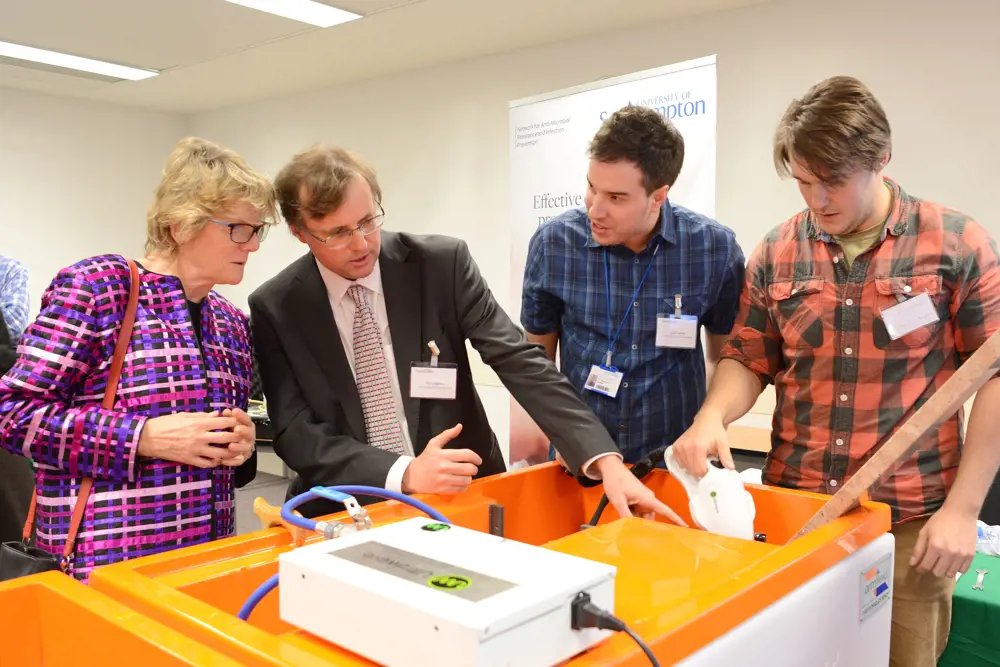
Professor Leighton and members of his team demonstrate StarStream to Professor Dame Sally Davies DBE FRS, Chief Medical Officer for England. An obvious application of this ultrasonic cleaning technology is in cleaning medical and dental instruments. Sold as StarStream, a company now has a licence to produce ultrasonic cleaners for just this purpose © Mengyang Zhu
Professor Leighton’s motivation is to see that the research into AMR delivers real benefits. “AMR may kill people under a massive mountain of published papers that nobody ever reads,” he adds. “I am really pleased and proud of the number of people in NAMRIP who have said ‘I see how we can translate research’ and have started thinking about doing it and doing it properly.”
NAMRIP has added to Professor Leighton’s thinking on the opportunities for ultrasonic cleaning in the fight against AMR. He is not ready to say too much about all the possibilities, but he likes the idea of taking the technology behind StarStream and turning it into a way of cleaning wounds, removing bacteria so that there is no need to treat some patients with antibiotics. As he points out: “each year, 6,000 amputations in diabetics alone occur in the UK at a cost of £1 billion, because we cannot clean and heal these infected wounds.”
each year, 6,000 amputations in diabetics alone occur in the UK at a cost of £1 billion, because we cannot clean and heal these infected wounds.
Professor Leighton has another related idea up his sleeve. “We know that the device cleans wounds so I thought, let’s try and trigger those wounds to heal as well.” Early results from his team of engineers and microbiologists, working with experts in skin research in the university’s Faculty of Health Sciences, show that the ‘toy factory’s’ latest invention, dubbed StarHealer, can increase healing by around 100%. This is just one of several ideas that Professor Leighton is reluctant to talk about too much before he has filed patents. “StarStream has got its patents all tied up. The others are on their way.” Another invention sets out to clean larger surfaces with ultrasound. “Often, you want to clean a larger flat area, it could be a floor, a solar panel or anything else,” says Professor Leighton. “StarGlider does this by hovering over a surface without touching it.” No need for brushes or other devices that could spread contamination. The University of Southampton team has even used the StarGlider technology to clean away ‘leaves on the line’, the slime that is created when train wheels crush autumn leaves on rails, making them slippery and forcing trains to slow down to maintain their braking.
Career timeline and distinctions
Born, 1963. Studied natural sciences, physics and theoretical physics at the University of Cambridge, 1982–1985. Awarded a PhD for image intensifier studies of sonoluminescence with applications to the safe use of medical ultrasound, 1988. Joined the University of Southampton as a lecturer in underwater acoustics, 1992. Appointed Professor of Ultrasonics and Underwater Acoustics, 1999. Awarded the Brian Mercer Award for Innovation, 2011. Fellow of the Royal Academy of Engineering, 2012. Fellow of the Royal Society, 2014. Founding Chair, Network for Anti-Microbial Resistance and Infection Prevention, 2015–present. Founding Chair, Health Effects of Ultrasound in Air, 2015–present. Awarded the Clifford Paterson Medal by the Royal Society, 2017.
From research to industry impact
Professor Leighton’s reticence about his new inventions is in part because he plans to accelerate the pace at which he gets the results of his research out into the world. The work behind the StarStream may have won him and Dr Peter Birkin the 2011 Royal Society Brian Mercer Award for Innovation, but it is not always easy to win research grants for this sort of work. He now hopes to take a more business-like approach to unleashing those ‘toys’ on the world.
The Mercer award, worth £250,000, supported the Southampton team in developing new products based on ultrasonic cleaning. Professor Leighton’s current challenge is to generate enough income to bring his portfolio of ideas to market, and to support the group’s basic research. As it is, industry already provides most of the money for Professor Leighton’s team, but it comes in small chunks, which makes it hard to manage. He hopes to change that by bringing a steady stream of inventions to the market.
Professor Leighton understands the need to maximise the impact of the research. He managed the engineering faculty’s input to the latest Research Excellence Framework (REF), which meant, as he puts it, persuading the faculty’s 200 academics with cake to get them to write submissions, including evidence of the impact of their research. Perhaps surprisingly, he claims that he enjoyed the REF process. “I did love a huge amount of what REF did for impact. It raised the bar for people who were saying ‘this research could be of some use to somebody, someday’ to having to say ‘number of lives saved, number of new doctors trained, number of new jobs, number of new dollars’.”
For all his enthusiasm for REF, Professor Leighton admits that it took up eight years of his life: four spent running REF and another four rebuilding the research group that had all but disappeared during the REF process. Now back up to strength, with five PhD students and three postdoctoral researchers, all of them at least part funded by industry, the team keeps the ‘toy factory’ busy. This year, they will also have to find room for half a dozen undergraduate research projects working on various inventions.
I think we have got a massive responsibility. We have been given this brilliant education, fantastic research facilities, and the taxpayer pays a lot for the pleasure of us being here. Let’s put something back. Let’s save lives with it
What drives Professor Leighton to go beyond adding to his group’s number of published papers? “I think we have got a massive responsibility. We have been given this brilliant education, fantastic research facilities, and the taxpayer pays a lot for the pleasure of us being here. Let’s put something back. Let’s save lives with it.”
***
This article has been adapted from "A talent for bursting bubbles", which originally appeared in the print edition of Ingenia 73 (December 2017)
Contributors
Michael Kenward OBE
Author
Keep up-to-date with Ingenia for free
SubscribeRelated content
Health & medical
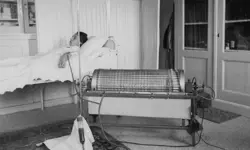
Kidney dialysis
Small haemodialysis machines have been developed that will allow more people to treat themselves at home. The SC+ system that has been developed is lighter, smaller and easier to use than existing machines.

Engineering polymath wins major award
The 2015 Queen Elizabeth Prize for Engineering has been awarded to the ground-breaking chemical engineer Dr Robert Langer FREng for his revolutionary advances and leadership in engineering at the interface between chemistry and medicine.
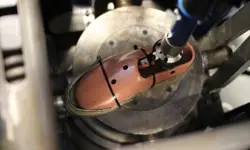
Blast mitigation and injury treatment
The Royal British Legion Centre for Blast Injury Studies is a world-renowned research facility based at Imperial College London. Its director, Professor Anthony Bull FREng, explains how a multidisciplinary team is helping protect, treat and rehabilitate people who are exposed to explosive forces.
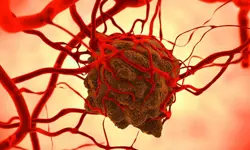
Targeting cancers with magnetism
Cambridge-based Endomag has helped treat more than 6,000 breast cancer patients across 20 countries. The MacRobert finalist uses magnetic fields to power diagnostic and therapeutic devices. Find about the challenges that surround the development and acceptance of medical innovations.
Other content from Ingenia
Quick read

- Environment & sustainability
- Opinion
A young engineer’s perspective on the good, the bad and the ugly of COP27

- Environment & sustainability
- Issue 95
How do we pay for net zero technologies?
Quick read

- Transport
- Mechanical
- How I got here
Electrifying trains and STEMAZING outreach

- Civil & structural
- Environment & sustainability
- Issue 95